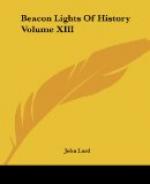The “Idylls of the King,” their deep ethical motive and underlying purpose.
His profound religious convictions and belief in the eternal verities.
Hallam Tennyson’s memoir of the poet; his friends and intimates.
The poet’s birth, family, and youthful characteristics
Early publishing ventures; his volume of 1842 gave him high rank.
Personal appearance, habits, and mental traits.
“In Memoriam,” its noble, artistic expression of sorrow for Arthur Hallam.
“The Princess” and its moral, in the treatment of its “Woman Question” theme.
The metrical romance “Maud,” and “The Idylls of the King,” an epic of chivalry.
“Enoch Arden,” and the dramas “Harold,” “Becket,” and “Queen Mary”.
Other dramatic compositions: “The Falcon,” “The Cup,” and “The Promise of May”.
The pastoral play, “The Foresters,” and later collections of poems and ballads.
The poet’s high faith, and belief that “good is the final goal of ill”.
His exalted place among the great literary influences of his era.
Expressive to his age of the high and hallowing Spirit of Modern Poetry.
LIST OF ILLUSTRATIONS
Volume XIII.
The Young Goethe at Frankfort Frontispiece After the painting by Frank Kirchbach.
Jean Jacques Rousseau
After the painting by M. Q. de la Tour, Chantilly,
France.
Sir Walter Scott
After the painting by Sir Henry Raeburn, R. A.
Lord Byron
After the painting by P. Kraemer.
Francois Marie Arouet de Voltaire
After the painting by M. Q. de la Tour, Endoxe
Marville
Collection, Paris.
Thomas Carlyle
After a photograph from life
Thomas Babington Macaulay
After a photograph by Maule, London.
William Shakspeare
After the “Chandos Portrait,” National
Portrait Gallery, London.
John Milton
After the painting by Pieter van der Plaas.
Milton Visits the Aged Galileo
After the painting by T. Lessi.
Goethe
After the painting by C. Jaeger.
Alfred (Lord) Tennyson
After the painting by G. F. Watts, R. A.
Tennyson’s Elaine
After the painting by T. E. Rosenthal.
BEACON LIGHTS OF HISTORY.
JEAN JACQUES ROUSSEAU.
1712-1778.
SOCIALISM AND EDUCATION.




